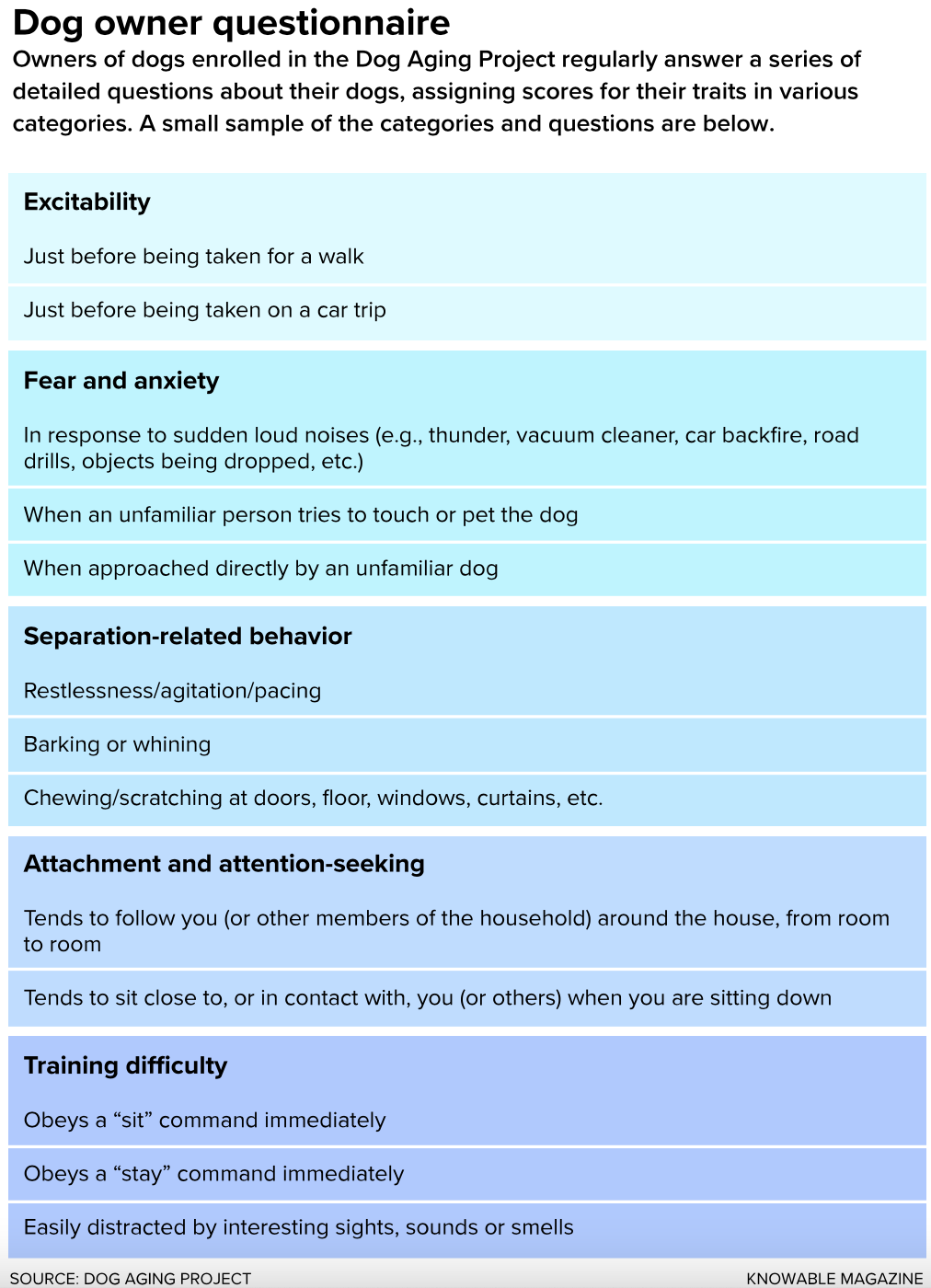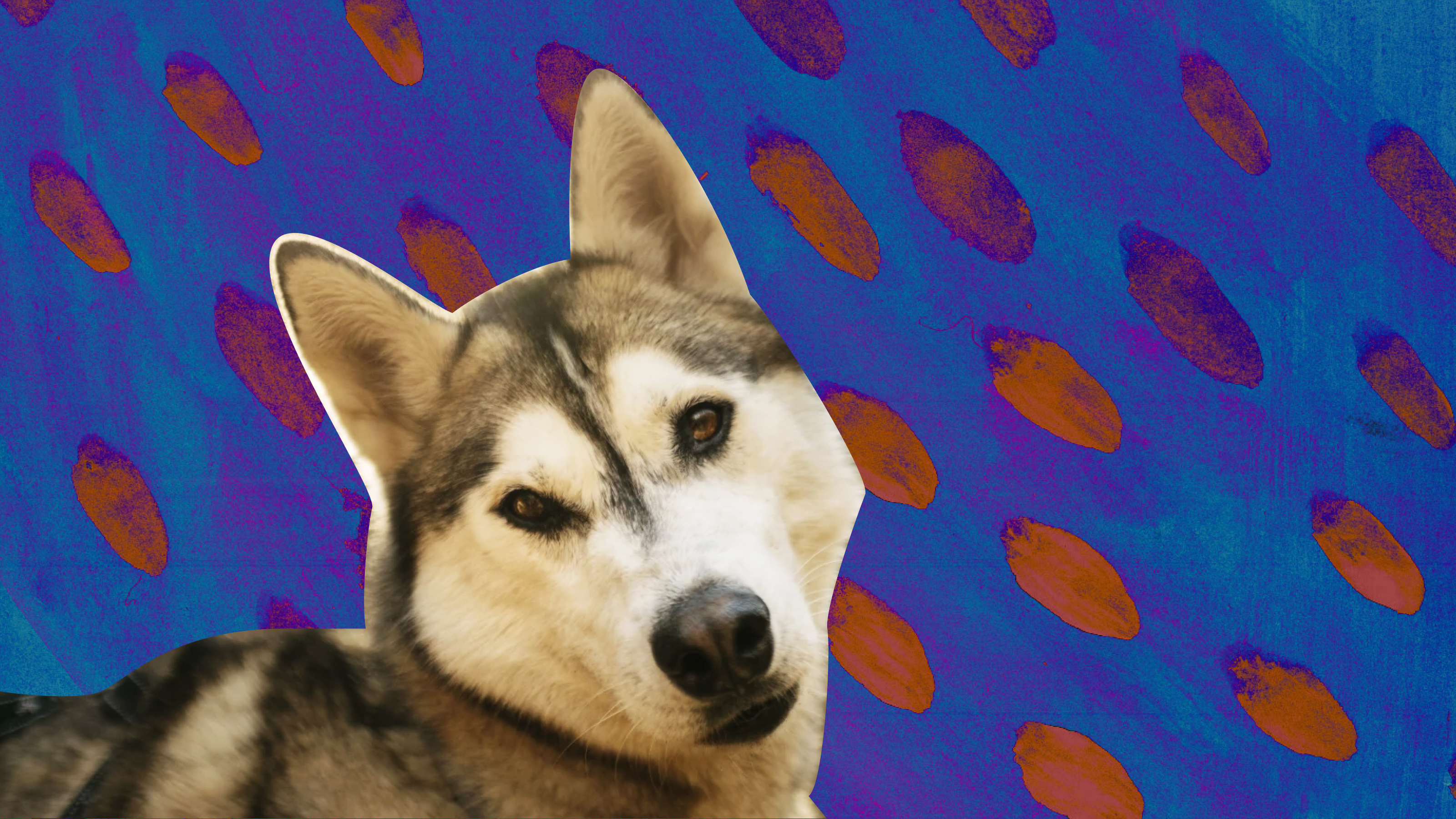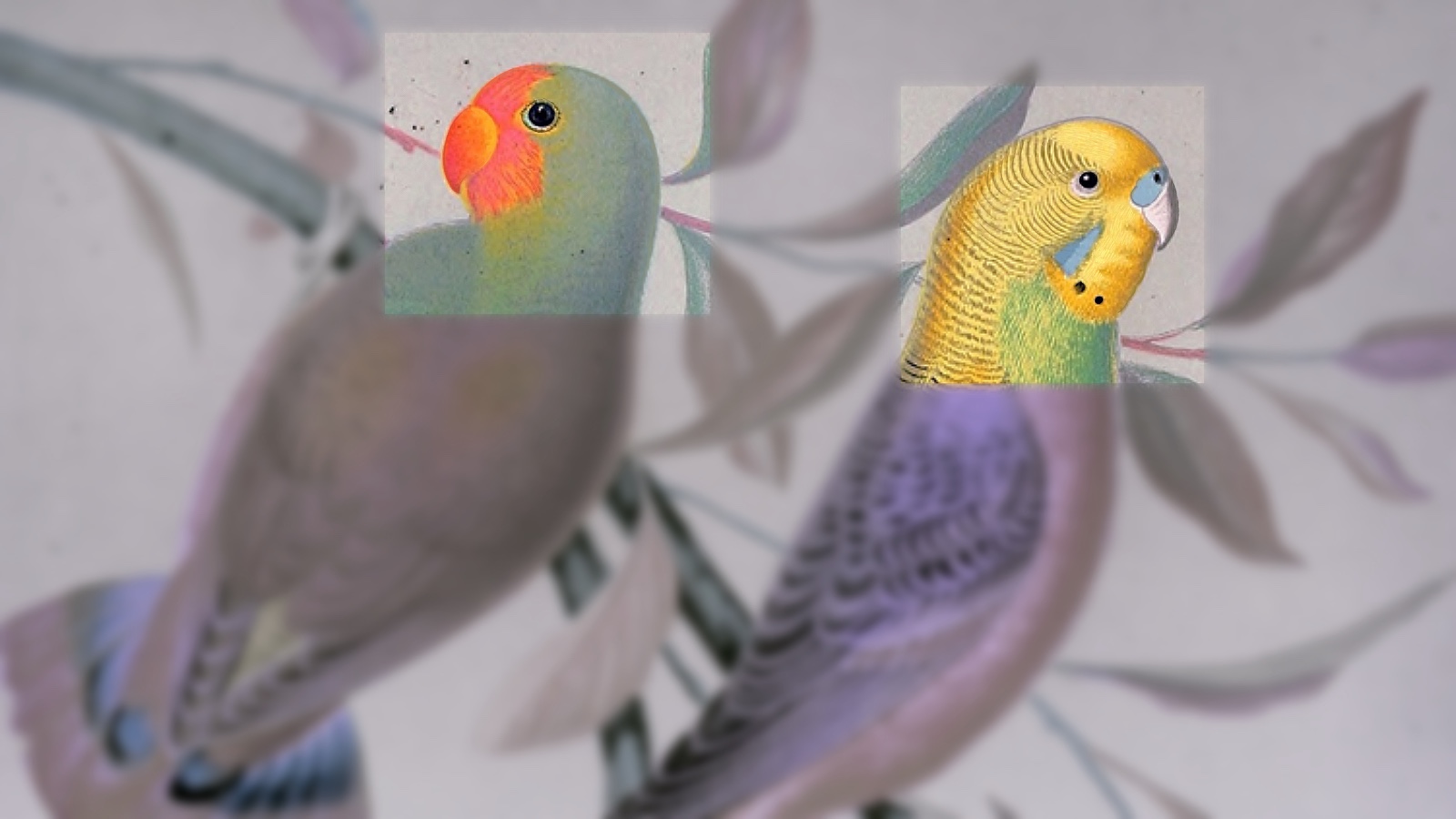Inside the brains of aging dogs

Hana aced her memory test. After viewing the contents of three identical boxes arrayed in an arc on the back deck of her home, the 3-year-old Cavalier King Charles spaniel had to remember which box held a treat — a task she quickly learned after just a few trials.
Hana and her human companion, Masami Shimizu-Albergine of Bainbridge Island, Washington, are helping scientists to learn something too: when dog smarts reach their peak and how they decline with age.
Hana is part of a pack that has grown to nearly 40,000 pet dogs enrolled in a citizen science initiative known as the Dog Aging Project, founded in 2014. Understanding the biology of aging in companion dogs is one of two main goals of the project, says cofounder and codirector Matt Kaeberlein, a pathologist at the University of Washington in Seattle who focuses on aging. “The other is to do something about it.”
Through veterinary records, DNA samples, health questionnaires and cognitive tests like Hana’s treat-finding challenge, the initiative of the University of Washington and Texas A&M University will track many aspects of dogs’ lives over time. Smaller subsets of the dogs, including Hana, will participate in more focused studies and more extensive evaluations. From all of this, scientists hope to spot patterns and find links between lifestyles and health from puppyhood through the golden years.
The effort joins that of an earlier one: the Family Dog Project, spearheaded in the 1990s at Eötvös Loránd University (ELTE) in Budapest to study “the behavioral and cognitive aspects of the dog-human relationship,” with tens of thousands of canines participating through the decades. The two projects have begun collaborating across continents, and the scientists hope that such a large combined group of dogs can help them tease out genetic and environmental factors that affect how long dogs live, and how much of that time is spent in good health.
With estimates of the number of pet dogs in the world reaching into the hundreds of millions, understanding how they age is important in its own right — to help improve their lives and the care they receive. But following the life journeys of some of these canine companions could provide hints that help people age more healthily as well, including what dogs might reveal about our own aging brains.
Because human aging takes place over many decades, studying the biology of that process is challenging. It means tracking people for 50, 60, 70 years or more, which can be laborious and expensive. In contrast, dogs age quickly. “This sucks for people who love their dogs,” says Kaeberlein, a lifelong dog lover. But it makes dogs an excellent model system for studying aging. (Though dog lifespan is strongly linked to body size, with Bernese mountain dogs averaging seven years and Chihuahuas nearly doubling that at 13 years, broadly speaking a 70-year study in people is roughly equivalent to one dog decade.)
Studying dogs has other advantages as well. Their genetic diversity makes them better animal models than the inbred strains of mice that are typically used in aging research. And though scientists often want to study their subjects in the controlled environment of a laboratory, the fact that pet dogs live in highly variable homes alongside people is actually a benefit when trying to glean insights that transfer to human aging. You can’t model a complex human environment in the laboratory. But if you study pet dogs, says Kaeberlein, there’s no need to.

Packing up
Scientists had long considered dogs to be “artificial animals” with unnatural behavior, says ELTE ethologist Enikő Kubinyi, who has studied cognition in pet dogs for nearly 30 years. In fact, when the Family Dog Project — to which she contributes — was pioneered by a group of Hungarian ethologists in 1994, many thought the idea was ridiculous, Kubinyi says. But attitudes have started to change. To date, the project has produced dozens of studies exploring dog behavior, genetics and neurobiology, across breeds and over time.
The Dog Aging Project, for its part, has conducted a small-scale clinical trial of 24 companion dogs that looked at the effects of a drug called rapamycin. The medication, used in people to combat rejection of transplanted organs and to treat cancer, has also been shown to extend lifespan in yeast, roundworms, fruit flies and mice. Heart scans revealed that dogs that had received rapamycin in that study, published in 2017, had improved heart function compared to dogs that got a placebo. Since then, the Dog Aging Project has begun a larger, longer-term rapamycin trial as part of its goal to study the biology of how dogs age more broadly.
Brain health is a key part of that. “There’s a lot we just don’t know about how dog cognition changes with age,” says comparative psychologist Evan MacLean, director of the Arizona Canine Cognition Center at the University of Arizona in Tucson and a collaborator on the Dog Aging Project. What is normal cognitive aging? Do early memory impairments signal later dementia? A longer-term aim, MacLean says, is to identify early interventions that could slow deterioration.
As part of that goal, MacLean’s collaborator Emily Bray, a psychologist at the University of Arizona and the service-dog organization Canine Companions, is designing a battery of cognitive tests for dogs based on rodent cognition studies (it includes the “1-2-3-treat” test that Hana performed). Some of these tests require the dogs to learn to interact with another ubiquitous fixture in the human environment: touch screens.
One test designed to study memory and learning, for example, involves three brightly colored, boldly patterned squares that dogs have been trained to associate with a specific location on the screen. During the test, dogs face a screen inside a wooden box and are supposed to touch the square with their noses only when it appears in its correct spot. Bray’s tests explore normal cognitive functioning, but they also target skills that may change with age and are dependent on brain regions affected by Alzheimer’s disease in people and its analog in dogs, known as canine cognitive dysfunction. Dogs — who learn to love screen time, based on their tail wagging — will be periodically tested to see how their memory and learning abilities hold up over time.
In another study, the two citizen science projects worked together and found, with the help of pet dogs donated post-mortem, that older dogs and those that exhibited dementia-like behaviors had increased levels in their brain of amyloid-beta, a misfolded protein that is also associated with Alzheimer’s disease in people. Most animal studies of Alzheimer’s disease have used mice that are genetically modified to develop dementia. But because dogs seem to develop canine cognitive dysfunction naturally, just like we do with Alzheimer’s, the researchers hope that their ongoing work with dog brains may also reveal clues that further understanding of the human disease.
A dog’s life
One of the strengths of tracking so many dogs over their lifetimes is that scientists will have enough data to start teasing out correlations between the aging process and dogs’ lifestyles, environments and habits. One factor they are looking closely at is physical activity, which has been shown to be protective for brain aging in people and some other species. Emerging results based on a survey of participants in the Dog Aging Project suggest the same may be true in dogs. To test the link, some of the participating dogs will wear a device “like a Fitbit, but for a dog,” Bray says.
Calorie restriction is also a hot topic in aging research: Scientists have shown that eating less and restricting when food is eaten can extend the lives of laboratory animals like mice. But outside of the controlled conditions of a lab, the picture is murkier. To help clear things up, Bray is leading a study comparing the eating habits of more than 10,000 dogs of multiple ages, sizes and breeds.
The results show that dogs fed just once daily — 8 percent of the total — were healthier on average. These single-meal dogs had fewer gastrointestinal, dental, orthopedic, kidney, urinary and other disorders than dogs fed two or more times a day. They also performed slightly better on cognitive tests. It’s unclear how eating less frequently improves cognition, Bray says, but the effect was stark: roughly the size of the difference in average cognitive scores between 7- and 11-year-old dogs.
So what’s going on inside dogs’ brains as they age? The Family Dog Project scientists in Hungary are tracking that. They have scanned dogs’ brains with EEGs and even trained dogs to stay still inside an fMRI machine, revealing that, like humans, their brains shrink with age.
In a similar imaging study, veterinary neurologist Stephanie McGrath at Colorado State University performs MRI scans on participants in the Dog Aging Project, looking for features that may connect brain shrinkage and other physical changes to dementia in older dogs. Most exciting, she says, is that her work suggests MRI might one day be used as an early detection tool.
New tricks
Elderly people have long been subject to ageism and an attitude of dismissal. Older dogs are no different, says University of Milan veterinarian Patrizia Piotti, a former collaborator on the Family Dog Project. Her research on problem-solving, memory and attention in dogs as they age has contributed to a body of work suggesting that while it is more challenging to teach an old dog a new trick, it may benefit their cognition to keep trying.
And, in fact, not all new tricks are harder for older dogs, according to researchers from the Clever Dog Lab at the Messerli Research Institute in Vienna. Comparative cognition expert Zsófia Virányi and her former student, Durga Chapagain, gave 119 pet dogs a series of 11 cognition tests involving tasks like viewing pictures, playing, finding hidden food and manipulating toys. They found that traits like problem-solving ability, boldness and playfulness declined predictably with age. But in a task where dogs had to learn to make eye contact with the trainer after finding and eating a piece of sausage dropped on the floor, a behavior rewarded with another piece of sausage, older dogs performed just as well.
This goes to show that we shouldn’t underestimate the mental capacities of senior dogs, Chapagain says. As dogs get older, “we are less inclined to play with them,” she says, but they may have the same motivation as younger dogs to keep learning (at least when sausage is involved). “They are capable of much more than we think.” People should keep their canine companions engaged in mental exercise like trick training and nose work like hiding treats for a game of sniff-and-seek throughout their lives, adds Piotti. “Anything that makes the dog think a little bit.”
Opportunity for older dogs was what motivated Titania Juang to enroll her dog Cash in the Dog Aging Project in 2019. From the time he was adopted as a rescue in 2010 at age 2 or 3, recalls Juang, Cash was a quirky character, preferring fruits and vegetables to meat. “He liked to walk really slowly … literally stopping to smell the flowers, looking out into the distance,” she says. Even as a youngster, recalls Juang, he acted a bit like an old man.
Cash passed away in 2021, but his canine scientific contribution lives on, helping science and medicine move forward. That brings some comfort to Juang. “He is no longer here, but it adds more value to his time with us.”
Kaeberlein can empathize with loss of a beloved aged pet. With dogs in the family all his life, his two passions — pet dogs and aging research — only recently came together. Sadly, Kaeberlein lost two of his three dogs during the pandemic. Dobby, a German shepherd and participant in the Dog Aging Project, remains. Named for his elflike appearance as a puppy, Dobby is all ears. And so is Kaeberlein, to see what scientific secrets dog aging research reveals over time.
This article originally appeared in Knowable Magazine, a nonprofit publication dedicated to making scientific knowledge accessible to all. Sign up for Knowable Magazine’s newsletter.






